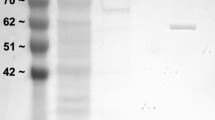Abstract
Lactate efflux from frog sartorius muscles was measured following a lactate load of about 18 μmol · g−1 induced by a 4-min period of stimulation. Lactate efflux rate was buffer concentration dependent. The initial efflux rate increased from about 150 nmol · g−1 · min−1 in 1 mM MOPS buffer to 400 nmol · g−1 · min−1 in 25 mM MOPS buffer. The addition of 20 mM propionate reduced mean intracellular pH by about 0.2 units and increased lactate efflux rate by 70% at the highest buffer concentration and 400% at the lowest buffer concentration. The observed results are in reasonable agreement with predictions based on a model in which net efflux is limited by diffusion of both buffer and lactate in the extracellular space. Transmembrane lactate efflux appears to consist of two components, one of which is proton linked and carried either by undissociated lactic acid or coupled proton-lactate transport, the other being carried by independent lactate ions.
Similar content being viewed by others
References
Aickin CC, Thomas RC (1977) An investigation of the ionic mechanism of intracellular pH regulation in mouse solues muscle fibres. J Physiol (London) 273:295–316
Brookes N, MacKay D (1971) Diffusion of labelled substances through isolated rat diaphragm. Br J Pharmacol 41:367–378
Cabantchik ZI, Rothstein A (1972) The nature of the membrane sites controlling anion permeability of human red blood cells as determined by studies with disulfonic stilbene derivatives. J Membr Biol 15:207–226
Deuticke B (1982) Monocarboxylate transport in erythrocytes. J Membrane Biol 70:89–103
Dubinsky WP, Racker E (1978) The mechanism of lactate transport in human erythrocytes. J Membr Biol 44:25–36
Dulhunty AF, Franzini-Armstrong C (1975) The relative contribution of the folds and calveolae to the surface membrane of frog skeletal muscle fibres at different sarcomere lengths. J Physiol 250:513–539
Goldman DE (1943) Potential impedance and rectification in membranes. J Gen Physiol 27:37–60
Gutknecht J, Tosteson DC, (1973) Diffusion of weak acids across lipid bilayer membranes: effects of chemical reaction in the unstirred layers. Science 182:1258–1261
Halestrap AP, Denton RM (1974) Specific inhibition of pyruvate transport in rat liver mitochondria and human erythrocytes by α-cyano-4-hydroxycinnamate. Biochem J 138:313–316
Hill AV (1965) Trails and trials in physiology. Edward Arnold, London, pp 208–241
Hinke JAM, Menard MR (1978) Intracellular pH of single crustacean muscle fibres by DMO and electrode methods during acid and alkaline conditions. J Physiol 262:533–552
Hodgkin AL, Katz B (1949) The effect of sodium ions on the electrical activity of the giant axon of the squid. J Physiol (London) 108:37–77
Hutter OF, Warner AE (1967) The effect of pH on the36Cl efflux from frog skeletal muscle. J Physiol 189:427–443
Karlsson J (1971) Muscle ATP, CP and lactate in submaximal and maximal exercise. In: Pernon B, Salton B (eds) Muscle metabolism during exercise. Plenum Press, New York, pp 383–399
Kindermann WL (1977) Physical exercise after induced alkalosis (bicarbonate or Tris buffer). Eur J Applied Physiol 37:197–204
Mainwood GW, Worsley-Brown P (1975) The effects of extracellular pH and buffer concentration on the efflux of lactate from frog sartorius muscle. J Physiol (London) 250:1–22
Mainwood GW, Cechetto D, St Jean M (1979) The effects of glucose and insulin on contraction of the isolated diaphragm. Can J Physiol Pharmacol 55:868–881
Marranes R, de Hemptine A, Leusen I (1981) pH aspects of transient changes in conduction velocity in isolated heart fibres after partial replacement of chloride with organic acids. Pflügers Arch 389:199–209
Mason MJ, Thomas, RC (1985) Evidence for facilitated diffusion ofl-lactate across frog skeletal muscle membranes. J Physiol 361: 23P
Meyer RA, Sweeney H Lee, Kushmeirick MJ (1984) A simple analysis of the “phosphocreatine shuttle”. Am J Physiol 246:C365-C377
Mobely BA, Eisenberg, BR (1975) Sizes and components in frog skeletal muscle measured by methods of stereology. J Gen Physiol 66:31–45
Renaud JM, Mainwood GW (1985) The effects of pH on the kinetics of fatigue and recovery in frog sartorius muscle. Can J Physiol Pharmacol 63:1435–1443
Sahlin K (1978) Intracellular pH and energy metabolism in skeletal muscle of man. Acta Physiol Scand (Suppl) 455:1–56
Spencer TE, Lehninger AL (1976)l-Lactate transport in Ehrlich acites tumour cells. Biochem J 154:405–414
Vanheel B, de Hemptine A, Leusen I (1985) Intracellular pH and contraction of isolated rabbit and cat papillary muscle: effect of superbuffering. J Mol Cell Cardiol 17:23–29
Waddell WJ, Butler TC (1959) Calculation of intracellular pH from the distribution of 5,5-dimethyl-2,4-oxazolidine dione (DMO); application to skeletal muscle of dog. J Clin Invest 38:720–729
Walter A, Gutknecht J (1984) Monocarboxylic acid permeation through lipid bilayer membranes. J Membr Biol 77:255–264
Walter A, Hastings D, Gutknecht J (1982) Weak acid permeability through lipid bilayer membranes. J Gen Physiol 79:917–933
Wolosin JM, Ginsberg M (1975) The permeation of organic acids through lecithin bilayers. Resemblance to diffusion in polymers. Biochem Biophys Acta 389:20–23
Woodbury JW, Miles PR (1973) Anion conductance of frog muscle membranes: one channel, two kinds of pH dependence. J Gen Physiol 62:324–353
Author information
Authors and Affiliations
Rights and permissions
About this article
Cite this article
Mason, M.J., Mainwood, G.W. & Thoden, J.S. The influence of extracellular buffer concentration and propionate on lactate efflux from frog muscle. Pflugers Arch. 406, 472–479 (1986). https://doi.org/10.1007/BF00583369
Received:
Accepted:
Issue Date:
DOI: https://doi.org/10.1007/BF00583369




